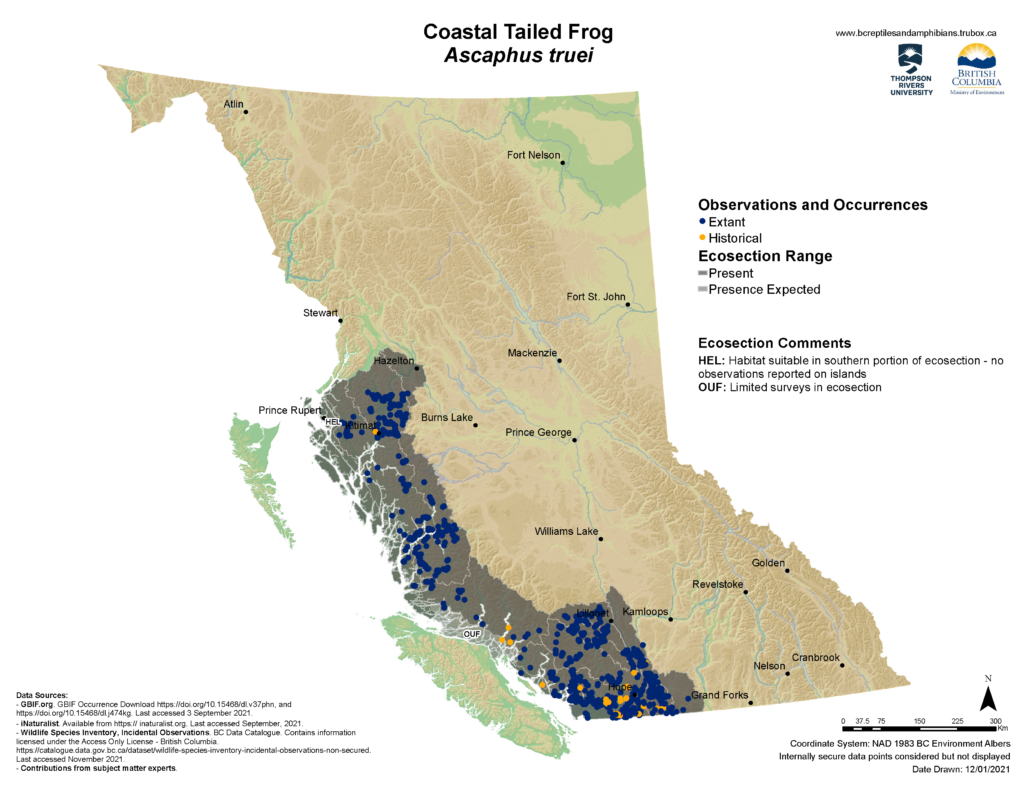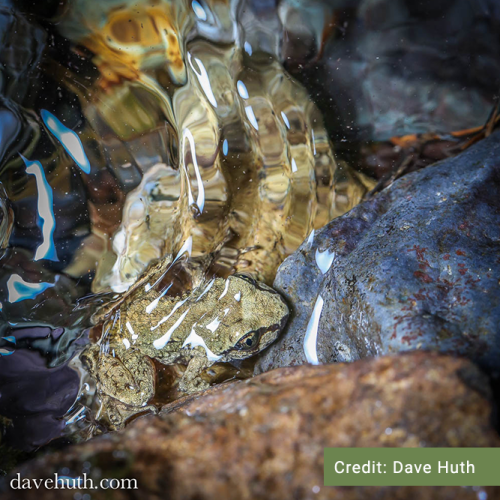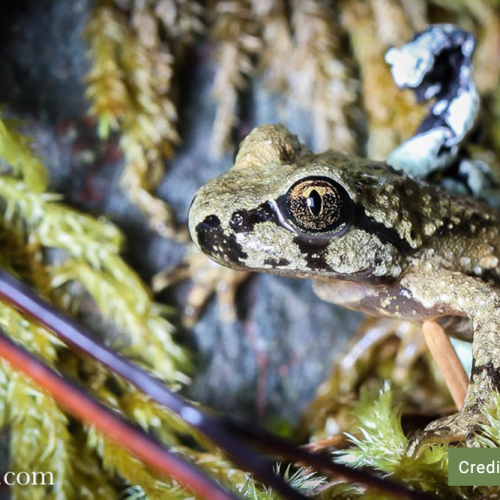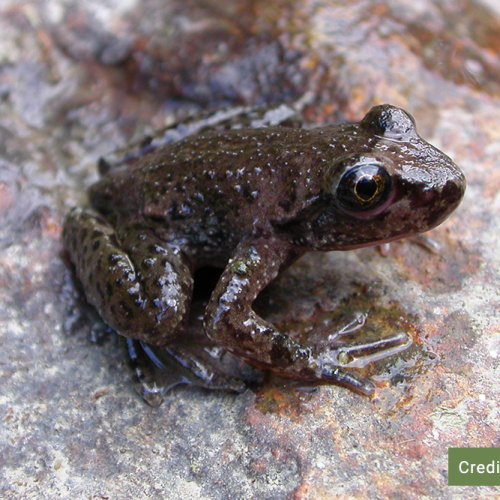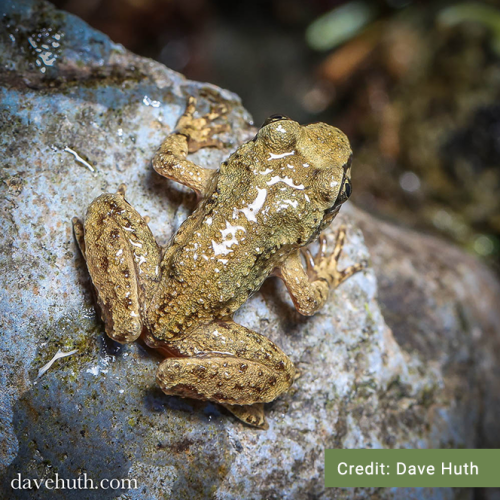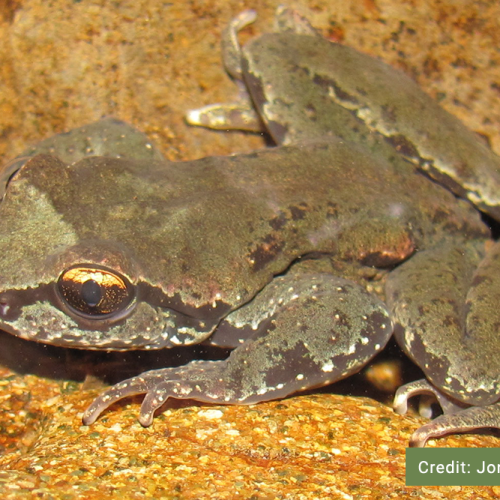Credit: Dave Huth
Coastal Tailed Frog
Ascaphus truei
Description
Other names: Pacific Tailed Frog, Western Tailed Frog
Coastal Tailed Frogs are very unusual looking frogs. They do not have an external eardrum (tympanumDefinition:The ear opening in many amphibians, reptiles, and insect. In amphibians, it is normally covered by a circular membrane.) and males have an external copulatory organ that looks like a tail. Coastal Tailed Frogs are small, growing to 4-5 cm in body length, and, like most other frogs, males are generally smaller than females. They can also be recognized by their vertical pupil, bumpy skin, flattened and webbed hind toes, and lack of dorsolateral foldsDefinition:Visible raised ridges of skin that run down part of all of the length of the back, usually on the sides.. Coastal Tailed Frogs are generally dark coloured and range from olive, grey, tan, brown, or black. They will sometimes have a dark-edged light bar or triangle between the eyes and some will have a dark stripe on the face. The belly is cream coloured. Both tadpoles and adults are well adapted to living in fast-flowing streams. Tadpoles have a sucker-like mouth that they use to cling to rocks and debris in fast-flowing water. The tadpole body is dorso-ventrally flattened with a low tail fin. They are dark grey or dark brown and get lighter in colour as they age. Tadpoles grow up to 6 cm in body length before metamorphosis. Coastal Tailed Frogs are the longest living frogs in North America, reaching up to 20 years of age.
Listen to the Indigenous words for “frog” here!
Coastal Tailed Frog Call
This species lacks a tympanum and, therefore, does not have a breeding call. This may be an adaptation to living with the constant noise of mountain streams.

Coastal Tailed Frog Call
This species lacks a tympanum and, therefore, does not have a breeding call. This may be an adaptation to living with the constant noise of mountain streams.
Similar Species
The Coastal Tailed Frog is very similar to the Rocky Mountain Tailed Frog, and the two were considered a single species until recently. The distributions of the two species do not overlap. The Rocky Mountain Tailed Frog has black speckling on the body, and tadpoles have distinct light mottling; both of these features are absent in Coastal Tailed Frogs. The Coastal Tailed Frog can be recognized from all other Canadian frogs by the absence of the tympanumDefinition:The ear opening in many amphibians, reptiles, and insect. In amphibians, it is normally covered by a circular membrane. and the presence of the ‘tail’ in males.
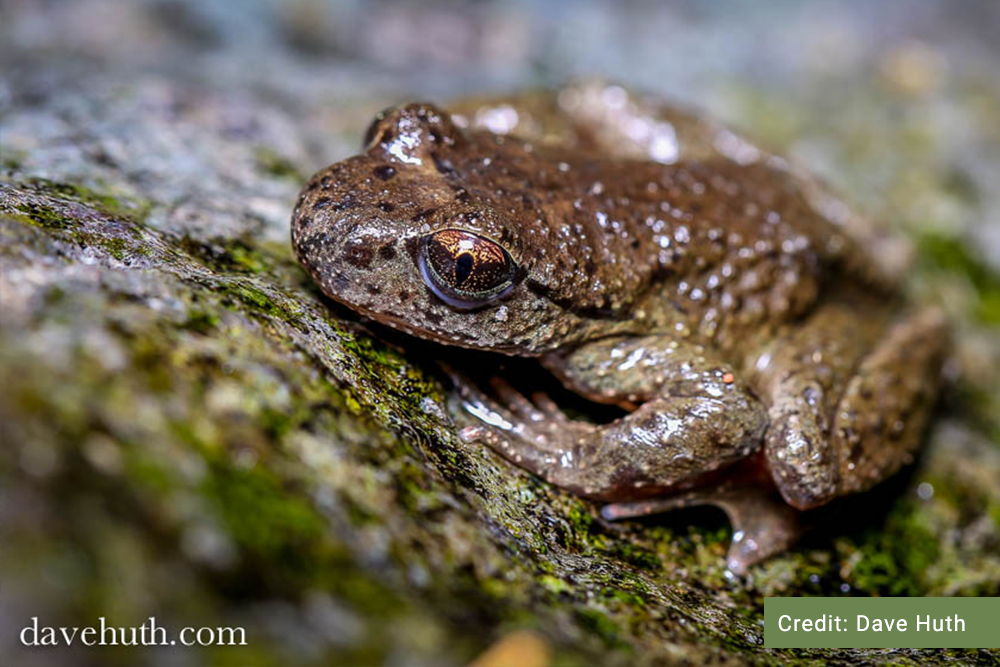
Coastal Tailed Frog

Rocky Mountain Tailed Frog
Distribution
Habitat
Reproduction
The breeding season for Coastal Tailed Frogs occurs from August to October. Coastal Tailed Frogs lay eggs later than the inland species, have smaller clutch sizes, shorter incubation periods, and smaller hatching sizes than the Rocky Mountain Tailed Frog. As they lack a tympanumDefinition:The ear opening in many amphibians, reptiles, and insect. In amphibians, it is normally covered by a circular membrane. and do not produce breeding calls; it is unknown how mates find each other. Tailed Frogs are the only frog species in North America that use internal fertilization. Mating occurs in streams after a successful courtship ritual. The male will use its ‘tail’ to transfer sperm directly into the female’s cloaca. The female will not lay eggs until the following summer. At that time, she will lay up to 1300 eggs in clusters of 30-80 by attaching them to the underside of rocks in flowing water. The eggs are creamy or yellowish in colour and are surrounded by jelly envelopes and enclosed in two strings. Eggs hatch after 4-6 weeks, but tadpoles do not undergo metamorphosis for 3-5 years in Canada. Coastal Tailed Frogs do not reach sexual maturity until 4 years after metamorphosis (or 7-9 years after hatching) and will live up to 20 years. Females will only breed every second year.
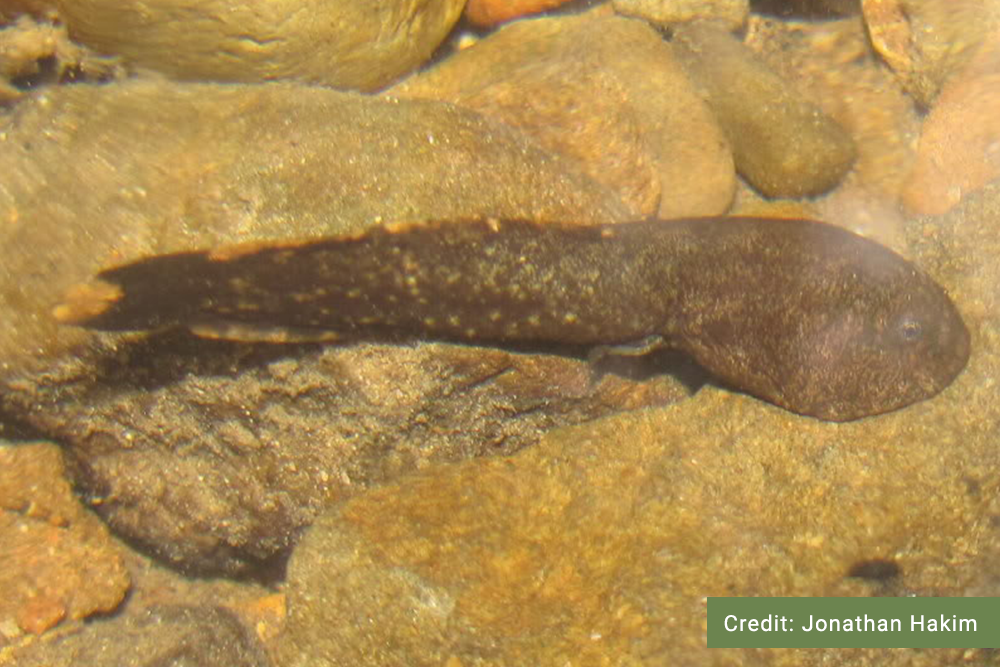
Diet

Conservation Status
Global: G4 (2016)
COSEWIC: SC
SARA:1-SC (2003)
Provincial: S4
BC List: Yellow
Learn more about conservation status rankings here
Threats

Did You Know?
Fact #1
Fact #2
Fact #3
Species Account Author: Marcus Atkins
Available:https://a100.gov.bc.ca/pub/eswp/ (accessed May 19, 2021).
Bury, R.B., and M.J. Adams. 1999. Variation in age at metamorphosis across a latitudinal gradient for the tailed frog, Ascaphus truei. Herpetologica 55: 283-91.
COSEWIC. 2011. COSEWIC assessment and status report on the Coastal Tailed Frog Ascaphus truei in Canada. Committee on the Status of Endangered Wildlife in Canada. Ottawa. xii + 53 pp. (www.registrelep-sararegistry.gc.ca/default_e.cfm).
Matsuda, B.M. 2001. The effects of clear-cut timber harvest on the movement patterns of Tailed Frogs (Ascaphus truei) in southwestern British Columbia. M.Sc. thesis, Department of Forest Sciences, University of British Columbia.
Matsuda, Brent M., David M. Green and Patrick M. Gregory. 2006. Amphibians and reptiles of British Columbia. Royal British Columbia Museum, Victoria.
Nielson, M., K. Lohman and J. Sullivan. 2001. Phylogeography of the Tailed Frog (Ascaphus truei): implications for the biogeography of the Pacific Northwest. Evolution 55: 147-60.
Richardson, J.S., and W.E. Neill. 1998. Headwater amphibians and forestry in British Columbia: Pacific giant salamanders and tailed frogs. Northwest Science 72: 122-123.
Van Horne, B. 1983. Density as a misleading indicator of habitat quality. Journal of Wildlife Management 47: 893-901.
Wahbe, T.R., and F.L. Bunnell. 2003. Relations among larval tailed frogs (Ascaphus truei), forest harvesting, stream microhabitat, and site parameters in southwestern British Columbia. Canadian Journal of Forest Research 33: 1256-1266.
http://linnet.geog.ubc.ca/efauna/Atlas/Atlas.aspx?sciname=Ascaphus%20truei&ilifeform=1
http://www.canadianherpetology.ca/species/species_page.html?cname=Coastal%20Tailed%20Frog
https://www.naturewatch.ca/frogwatch/tailed-frog/
https://www2.gov.bc.ca/gov/content/environment/plants-animals-ecosystems/wildlife/wildlife-conservation/amphibians-reptiles/amphibians-in-b-c/frogs-toads
http://a100.gov.bc.ca/pub/eirs/finishDownloadDocument.do?subdocumentId=1304
https://species-registry.canada.ca/index-en.html#/documents/1550

